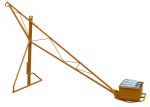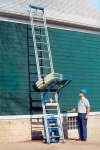Roofing contractors are being challenged on a daily basis. I notice firsthand that contractors are trying to be more competitive by trimming production times, managing quality control, and adhering to strict safety requirements. This effort to complete a job quickly while maintaining a safe job site at times can be overwhelming and conflicting to a contractor.
These competing forces can be extremely dangerous when not carefully monitored. An example of this is when roofing materials cannot be staged on the roof and instead are delivered to the ground. This presents the contractor with the dilemma of how to deliver the material to the rooftop. Few OSHA agencies permit contractors to carry roofing materials while climbing a ladder (see
this OSHA ladder safety article for guidelines.) The American Ladder Institute (ALI) recommends utilizing the “
Three Point-of-Contact” method when climbing a ladder, keeping hands free and focused on climbing.
With these regulations and recommendations in mind, as well as the weight of the load, roofers are left with the following options:
- Rent/own a crane
- Rent/own a telescopic forklift
- Purchase a non-powered hoist (e.g., Roofmaster hoisting wheels, Laddermasters, or hand powered hoists)
- Purchase a powered hoist (e.g., Reimann & Georger hoists)

300lb 14′ Non-Swing Hand Hoist w/Ballast Tray
Options 3 and 4 are the cheapest and the most popular within the roofing industry and an area where Roofmaster can provide expert advice and service. Most non-powered hoisting equipment have a load limit of 150 pounds, whereas some powered equipment have a max load of 400 pounds. Roofmaster has manufactured OSHA compliant non-powered hoisting equipment since 1972. In addition, Roofmaster has been a preferred distributor of Reimann & Georger (now RGC) powered hoisting equipment since the 1950s.

One of the most popular and efficient powered hoists is the
PRO Platform Hoist with a Honda motor. This product can easily be transported in a pickup and set up on site with 2 people. The PRO400 can lift loads up to 400# as low as 12 ft (28 ft unit), or as high as 40 ft. (44 ft unit). These units can be used indoors (
electrical motor version) in warehouses, construction sites, etc., where cranes, forklifts, or other lifting equipment make not be possible, and outdoors (
gas engines), to lift materials or equipment to higher elevations.
Speak with a Roofmaster salesperson today to learn more about how our lineup of
hoisting equipment can help increase job site safety.

 One of the most popular and efficient powered hoists is the PRO Platform Hoist with a Honda motor. This product can easily be transported in a pickup and set up on site with 2 people. The PRO400 can lift loads up to 400# as low as 12 ft (28 ft unit), or as high as 40 ft. (44 ft unit). These units can be used indoors (electrical motor version) in warehouses, construction sites, etc., where cranes, forklifts, or other lifting equipment make not be possible, and outdoors (gas engines), to lift materials or equipment to higher elevations.
Speak with a Roofmaster salesperson today to learn more about how our lineup of hoisting equipment can help increase job site safety.
One of the most popular and efficient powered hoists is the PRO Platform Hoist with a Honda motor. This product can easily be transported in a pickup and set up on site with 2 people. The PRO400 can lift loads up to 400# as low as 12 ft (28 ft unit), or as high as 40 ft. (44 ft unit). These units can be used indoors (electrical motor version) in warehouses, construction sites, etc., where cranes, forklifts, or other lifting equipment make not be possible, and outdoors (gas engines), to lift materials or equipment to higher elevations.
Speak with a Roofmaster salesperson today to learn more about how our lineup of hoisting equipment can help increase job site safety.




